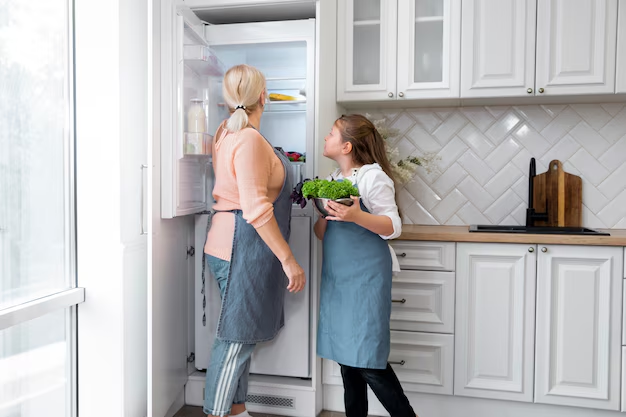Will Your Refrigerator Survive the Cold? A Guide to Using a Fridge in a Cold Garage
When the weather outside turns chilly and snow piles on the driveway, you might wonder if your trusty refrigerator in the garage will keep your food just as fresh as it does in the heat of summer. Whether you're planning to use your garage as extra storage space or are just curious about how cold environments might impact your appliances, understanding how a fridge functions in cold temperatures is key. Let's dive into this topic fully to ensure you have everything you need to keep your food safe and cold, whatever the weather.
🌡️ Understanding Refrigerator Functionality
Basic Refrigerator Mechanics
Refrigerators function by using a refrigeration cycle to remove heat from inside the unit, keeping perishables cool. The appliance is designed to work within a specified temperature range, typically between 37°F and 41°F for the fridge compartment and around 0°F for the freezer. To maintain these temperatures, refrigerators rely on sensors and thermostats that signal the compressor to activate when the internal temperature rises above the set level.
Impact of Low Ambient Temperatures
When your fridge is placed in a cold garage, especially those facing winter lows, its operation can be affected. Traditional fridges are designed for environments maintained at consistent indoor living temperatures. If the air around the fridge gets too cold, the compressor might not kick in frequently enough, risking the temperature in the fridge and freezer compartments not being maintained adequately.
🚗 Cold Garages & Refrigerators: The Key Challenges
Why a Cold Garage Can Confuse Your Fridge
When ambient temperatures drop near or below the internal temperature of the fridge, the appliance may not run as expected. If your garage temperature drops to 35°F, for example, the internal mechanisms signal that the fridge compartment doesn’t need cooling. Consequently, your freezer may not stay cold enough since the compressor is simply not running frequently enough.
Potential Risks & Problems
- Temperature Fluctuation: Inconsistencies in running cycles may lead to fluctuating temperatures, spoiling food or causing freezer burn.
- Compressor Overload: If temperatures rise unexpectedly, your fridge compressor might overcompensate, potentially leading to wear and tear.
- Ice Build-Up: Low ambient temperatures can cause condensation to freeze around coils or vents, leading to frost build-up.
⛄ Practical Solutions & Considerations
Selecting the Right Fridge for a Cold Garage
- Garage-Ready Models: Some manufacturers offer garage-ready models designed to operate in a wider ambient temperature range. Consider these models if you're planning long-term use in an unheated garage.
- Thermostat Settings: Adjusting your refrigerator's thermostat to compensate for colder temperatures can help ensure proper function.
Insulating & Enhancing Garage Conditions
- Insulation: Adding insulation to your garage can maintain a more stable temperature around your fridge.
- Heaters: Using space heaters strategically can keep the garage environment within operable conditions for your appliance.
- Weather Stripping: Seal gaps and cracks to prevent cold air ingress.
Regular Maintenance Tips
- Monitor Temperature: Use a separate appliance thermometer to ensure the internal temperature is maintained properly within both compartments.
- Check for Ice Build-Up: Regularly inspect and defrost if necessary to ensure airflow and efficiency.
🛠️ Adjusting Home Practices & Planning
Smart Scheduling
- Stocking Frequency: Consider stocking perishable items more often and using timely rotations to avoid potential spoilage.
Adopting Energy Efficient Strategies
- Energy Savings: Although energy consumption might decrease as the compressor cycles less frequently, be cautious of its long-term impacts.
- Regular Cleaning: Keep condenser coils clean to optimize appliance energy usage, especially in challenging environments.
📝 Essential Takeaways for Cold-Weather Appliance Use
Here’s a handy summary to keep your fridge running smoothly in those colder months:
- 📍 Location Matters: Opt for a garage-ready refrigerator model for long-term solutions.
- ⏲️ Monitor Internals: Use a thermometer to double-check internal temperatures regularly.
- 🔧 Maintain & Inspect: Regularly inspect for ice build-up, seal leaks, and clean components for optimal use.
- 🏠 Home Adjustments: Consider insulating the garage or using space heaters to stabilize temperature fluctuations.
- ✅ Be Proactive: Stay vigilant about changes to promote food safety and appliance longevity.
In conclusion, while a refrigerator can function in a cold garage within limits, some adjustments and precautions are necessary to ensure efficacy and longevity. By understanding the dynamics of cold temperatures on your appliance and taking proactive measures, you can maintain cold storage effectively throughout the winter months.
